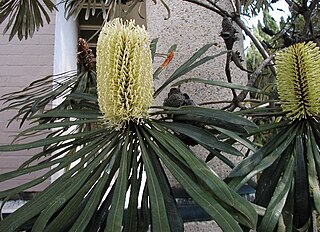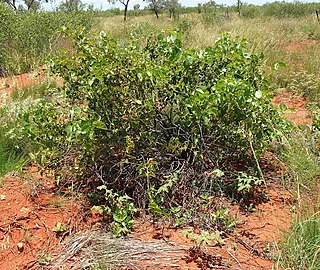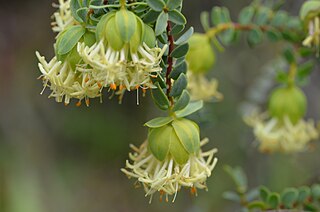
Banksia aquilonia, commonly known as the northern banksia and jingana, is a tree in the family Proteaceae and is endemic to north Queensland on Australia's northeastern coastline. With an average height of 8 m (26 ft), it has narrow glossy green leaves up to 20 cm (7.9 in) long and 6 to 10 cm high pale yellow flower spikes, known as inflorescences, appearing in autumn. As the spikes age, their flowers fall off and they develop up to 50 follicles, each of which contains two seeds.

Tasmannia stipitata, commonly known as the Dorrigo pepper or northern pepperbush is a rainforest shrub of temperate forests of the Northern Tablelands of New South Wales, Australia. Leaves are fragrant, narrow-lanceolate to narrow-elliptic, 8–13 cm long. Dark bluish to mauve berries follow the flowers on female shrubs. The species is dioecious, with male and female flowers on separate plants.

Ipomoea costata, commonly known as rock morning glory, is an Australian native plant. It is found in northern Australia, from Western Australia, through the Northern Territory, to Queensland.

Normanbya is a monotypic genus of palms containing the single species Normanbya normanbyi, which is known by the common name black palm It is endemic to Queensland, Australia and is threatened by habitat destruction.

Ficus fraseri, the white sandpaper fig or shiny sandpaper fig, is one of several fig species commonly known as sandpaper figs. It is native to New South Wales, Queensland and the Northern Territory in Australia and to New Caledonia and Vanuatu. Other common names are "figwood" and "watery fig".

Haemodorum coccineum is a flowering plant in the same family as kangaroo paw.

Psydrax oleifolia, commonly known as wild lemon or brush myrtle, is a species of shrub or small tree in the family Rubiaceae. It is endemic to eastern and inland Australia,.

Ammannia multiflora, commonly known as many-flower ammannia and jerry-jerry in Victoria, is a species in the family Lythraceae. It is widespread in Asia, tropical and sub-tropical Africa and Australia. It can be found in shallow water and damp heavy soils.

Cuscuta australis, commonly known as Australian dodder, is a herb in the family Convolvulaceae.
The Australasian Virtual Herbarium (AVH) is an online resource that allows access to plant specimen data held by various Australian and New Zealand herbaria. It is part of the Atlas of Living Australia (ALA), and was formed by the amalgamation of Australia's Virtual Herbarium and NZ Virtual Herbarium. As of 12 August 2014, more than five million specimens of the 8 million and upwards specimens available from participating institutions have been databased.

Amyema maidenii is a species of flowering plant within the genus Amyema, an epiphytic hemiparasitic plant of the family Loranthaceae native to Australia and found Australia-wide in the inland.

Scaevola canescens is a species of plant in the family Goodeniaceae. It is endemic to Western Australia where it occurs "from Shark Bay to Perth, in open forest and heath in sandy soil".

Atriplex fissivalvis, commonly known as gibber saltbush, is a plant species in the family Amaranthaceae, subfamily, Chenopodioideae. It occurs in the Australian states of South Australia, New South Wales, Queensland and the Northern Territory.

Pimelea sulphurea is a plant in the Thymelaeaceae family.
Hakea oligoneura is a small rare shrub known from only a few populations south of Perth, Western Australia growing exclusively on coastal limestone ridges. It has cream-white flowers and stiff, thick yellow-greenish leaves.

Marsippospermum gracile, common name - alpine rush, is a flowering plant species in the rush family Juncaceae which is native to New Zealand.
Protea pudens, also known as the bashful sugarbush, is a low-growing, groundcover-like, flowering shrub in the genus Protea. It is only found growing in the wild in a small area in the Western Cape province of South Africa.

Ptilotus schwartzii is a grass-like plant in the Amaranthaceae family.

Tribulus occidentalis, common name perennial caltrop, is a species of flowering plant in the family Zygophyllaceae, which is native to Australia, and found in Western Australia, Queensland, South Australia and the Northern Territory.

Gyrostemon subnudus is a plant in the family, Gyrostemonaceae. It was first described as Amperea subnuda in 1848 by Nees von Esenbeck, and transferred to the genus, Gyrostemon in 1873 by Henri Ernest Baillon.



















